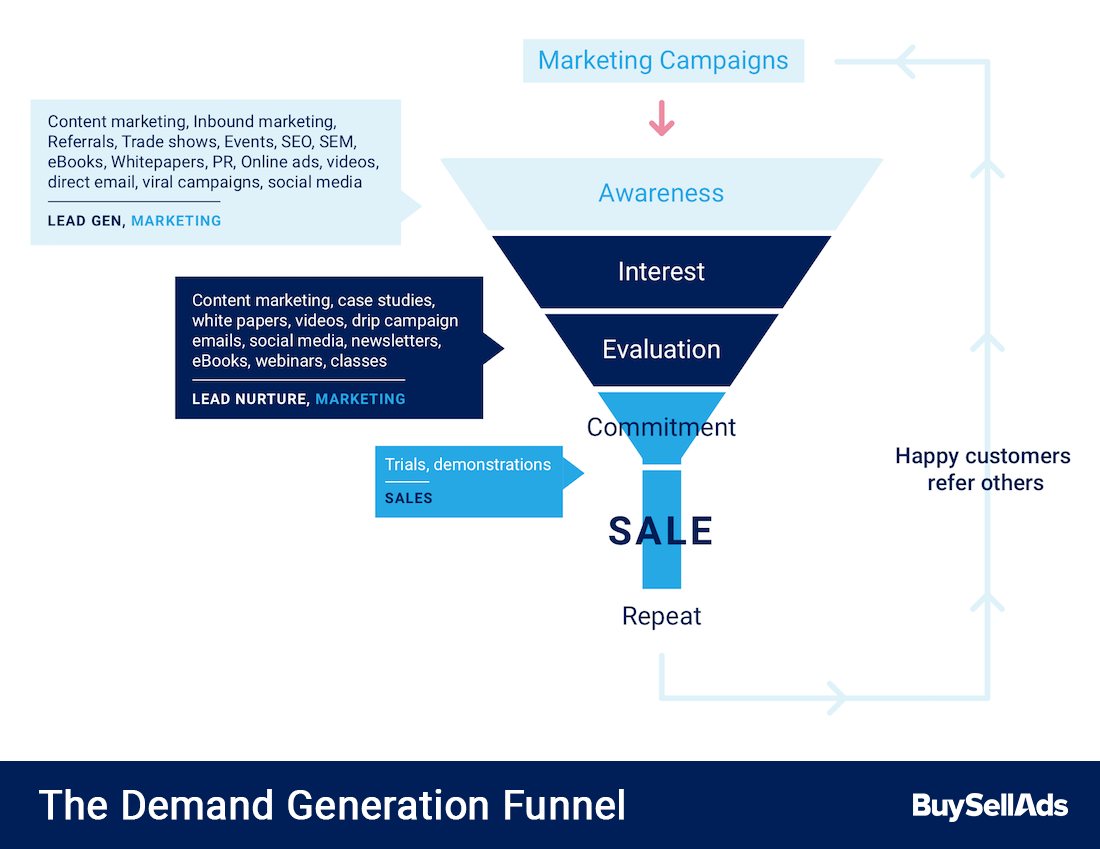As a marketer, you’re probably under huge pressure to grow revenue and send better leads to the sales team… and that pressure only increases each quarter.
You can panic, or you can build a demand generation strategy that saves the day.
With these strategies, you can map out your ideal customer and outline the tactics and channels used to move people towards a sale.
Before diving into writing a strategy, it’s important to understand how demand generation marketing works and the key parts of a demand generation strategy. Keep reading or check out our Slideshare below to learn more.
What is demand generation marketing?
At its core, the definition of demand generation is:
Demand generation marketing creates need for a product or service with the goal of passing qualified leads to the sales team.
That means demand generation is concerned about creating demand at the top of the funnel and getting qualified leads at the bottom.
At first, this might sound similar to lead generation or inbound marketing. In most cases, these approaches are part of the demand generation strategy but not the entire thing.
The demand generation funnel
Demand generation marketing plans bridge the marketing and sales funnels, covering everything from first interaction (such as a newsletter subscription or content download) to when a qualified lead becomes a customer.

The close relationship between marketing and sales aligns the teams with the same end goal and understanding of what it takes to make that happen. Basically, the two teams have to work together to ensure the funnel works efficiently at either end.
Who uses demand generation
Any marketer can use demand generation strategies to grow leads and revenue. However, a few things make B2B demand generation more common than B2C. These include:
- The demand generation process with its many lead stages is better suited to the longer, relationship-based sales process of B2B.
- Demand generation combines channels for lead nurturing, which can help a user get buy-in from various team members.
- Some B2C marketers might not even refer leads to a sales team, instead offering direct sign-up for a service or purchase of a product.
The components of a demand generation marketing plan
Demand generation strategies aren’t wildly different from other marketing plans you’ve written in the past. The biggest contrast is how demand generation’s funnel approach makes your plans more visual.
Your strategy can take on different formats and lengths, but all demand generation strategies should include these four components: audience, goals, funnels, and tactics.
1. Define your audience
You should already know who your product or service caters to, even in a general sense. Forcing product-market fit will go nowhere, so make sure your product is of actual value to target audiences before trying to market it.
If you’re trying to figure out where to start with your strategy, keep these demand generation best practices in mind:
- Don’t be too broad: Stick to smaller audiences at the beginning of launching a product. It’s easier to speak to and target a specific group of people.
- Find their preferences: Research how your audience discovers products like yours. Look for news organizations, blogs, competitors, influencers, social media, etc.
- Create target personas: Once you have a clear picture of a target audience, create personas that put a face and name to a particular segment.
Looking for more information on defining your audience? Our free Demand Generation Strategy Playbook goes in-depth on tools and research methods to help you pinpoint your best market.
2. Set goals
Setting KPIs and goals at the beginning helps you pick the right tactics and budgets to make your strategy a success.
Are you trying to increase sales leads? Do you want to raise customer lifetime values? Are you focused on selling a specific product? All of these questions require different metrics and approaches, so think it through.
When setting goals, consider the following:
- Keep them SMART: As with any marketing plan, demand generation goals should be specific, measurable, achievable, realistic, and timed.
- Work with sales: The entire point of demand generation is to send qualified leads to the sales team. Run numbers by sales before launching the strategy, and build a lead scoring formula alongside sales so everyone is working with the same expectations.
Free Download: Get expert tips on creating a demand generation strategy that converts new customers. Download our Playbook today.
3. Map the customer journey
Demand generation strategies can span weeks or months, so it’s important that you have a clear set of rules for graduating people through your funnel. For each stage, you should outline:
- What makes someone qualified for that lead status
- What actions move a person to the next stage of the funnel
- What actions remove someone from the funnel entirely
- Target conversion rate for each stage of the funnel
4. Fill in your funnel with demand generation tactics
There are no right or wrong ways to approach tactics, and what works for one marketer probably won’t apply to another. Go back to the research you did at the beginning and consider which channels and messages your target audience would most want to engage with.
Demand generation strategies incorporate many channels and rely on marketing automation to keep things humming. To scale up without breaking your budget, check out this list of 31 free demand generation software and tools.
Top-funnel demand generation tactics
At the top of the funnel, your goal is to raise awareness and create demand for a product by explaining what problems it solves. A victory is getting contact information to begin lead nurturing.
Channels might include:
- Advertising
- Giveaways
- Free online tools
- Social media
- Blog posts
- Reports and research
- Press coverage
- Webinars
If you have the budget and the time, don’t be afraid to get clever. Check out these creative demand generation ideas from successful startups.
Mid-funnel demand generation tactics
Now, it’s time to educate leads with content that builds trust. Invest in your audience with useful content now, and they will reward you with attention and perhaps a sale.
Demand generation activities used during this stage might include:
- Email campaigns
- Newsletters
- Blog posts
- Large content pieces
- Case studies
- Webinars
Bottom funnel demand generation tactics
Sales is in charge at the bottom of the funnel, but that doesn’t mean marketing is off the hook. Make sure the sales team has the resources they need and that marketing is prepared to re-introduce leads into the funnel for future sales and loyalty programs.
Tactics could include:
- Surveys
- Case studies
- Referral programs
Put it all together to form your strategy
Demand generation marketing strategies aren’t rocket science. The key is having a solid understanding of your audience and your product’s value in their lives—the rest is easy!
If you want to dive deeper, check out our free Demand Generation Strategy Playbook. The 50-page PDF is filled with actionable advice on reaching new customers and creating strategies for sustainable growth.

